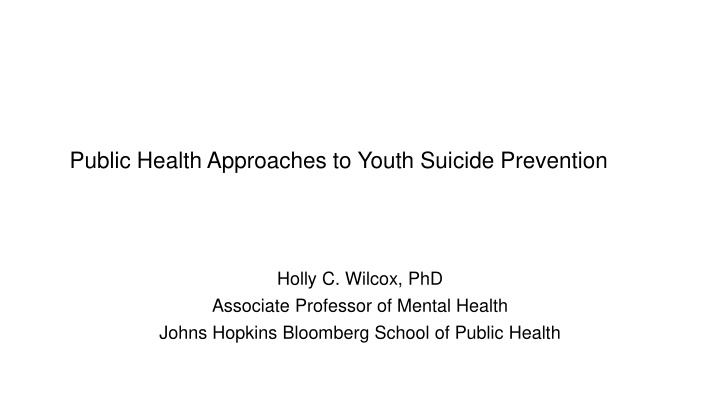



Public Health Approaches to Youth Suicide Prevention Holly C. Wilcox, PhD Associate Professor of Mental Health Johns Hopkins Bloomberg School of Public Health
Leading causes of death – United States, 2015 Rank Cause Number of deaths 1 Heart Disease 633,842 2 Malignant Neoplasms 595,930 3 Chronic Lower Respiratory Ds 155,041 4 Unintentional Injuries 146,571 5 Cerebrovascular Ds 140,323 6 Alzheimer’s Disease 110,561 7 Diabetes mellitus 79,535 8 Influenza and pneumonia 57,062 9 Nephritis 49,959 10 Suicide 44,193 Source: CDC vital statistics
Completed suicide rates are increasing in the United States Curtin SC, Warner M, Hedegaard H. Increase in suicide in the United States, 1999–2014. NCHS data brief, no 241. Hyattsville, MD: National Center for Health Statistics. 2016.
The magnitude of the increases vary by age Girls and women Boys and men Curtin SC, Warner M, Hedegaard H. Increase in suicide in the United States, 1999–2014. NCHS data brief, no 241. Hyattsville, MD: National Center for Health Statistics. 2016.
Leading causes of death for selected age groups – United States, 2015 Rank 10-14 years 15-19 years 20-29 years 30-39 years 40-49 years 50-59 years 1 Unintentional Unintentional Unintentional Unintentional Malignant Malignant Injuries Injuries Injuries Injuries Neoplasms Neoplasms 2 Malignant Heart Heart Suicide Suicide Suicide Neoplasms Disease Disease 3 Homicide Homicide Malignant Unintentional Unintentional Suicide Neoplasms Injuries Injuries 4 Homicide Malignant Malignant Heart Liver Suicide Neoplasms Neoplasms Disease Disease 5 Congenital Heart Heart Homicide Liver Chronic Malformations Disease Disease Disease Lower Respiratory Ds 6 Heart Congenital Diabetes Liver Disease Diabetes Diabetes Disease Malformations Mellitus Mellitus Mellitus 7 Chronic Influenza and Congenital Diabetes Cerebro- Suicide Pneumonia Lower Respiratory Malformations Mellitus Vascular Ds 8 Cerebro- Chronic Complicated Cerebro- Homicide Cerebro- pregnancy Vascular Lower Vascular Vascular Respiratory Ds Source: CDC vital statistics
Suicide rates among all persons by age and sex--United States, 2015 50 Rate per 100,000 population 40 30 Males Females 20 10 0 + 4 9 4 9 4 9 4 9 4 9 4 9 4 9 4 9 4 0 0 1 1 2 2 3 3 4 4 5 5 6 6 7 7 8 5 - - - - - - - - - - - - - - - - - 8 0 5 0 5 0 5 0 5 0 5 0 5 0 5 0 5 0 0 0 1 1 2 2 3 3 4 4 5 5 6 6 7 7 8 Age Group in years Source: CDC vital statistics
Suicide by method among persons aged 10-24 years and all, United States, 2015 Fall Other Fall Poisoning 3.1% 3.9% 2.3% 7.3% Poisoning Other 15.4% 5.6% Firearms Cut/pierce 44.1% 1.7% Firearms 49.8% Suffocation Suffocation 39.9% 26.8% Source: CDC vital statistics
Age-adjusted suicide rates among all persons by state -- United States, 2015 (U.S. avg 13.3) DC Rate per 100,000 4.9-10.3 10.4-13.3 13.4-17.9 Source: CDC vital statistics 18.0-28.2
Key points about adolescent suicide and suicide attempts • First onset of mental disorders usually occur in childhood or adolescence (Kessler et al., 2007). • Younger individuals may not know which methods are lethal - a cry for help could be fatal • Family contextual factors important
Key points about adolescent suicide and suicide attempts • The prefrontal cortex, implicated in higher order executive functions, emotional control, impulsivity, and decision making, continues to mature into the mid-20s (Gogtay et al., 2004; Steinberg, 2008). • Young individuals can be more vulnerable to contagion (Insel & Gould, 2008) • Evidence has accumulated to support the idea that suicidal behavior is “contagious” in that it can be transmitted, directly or indirectly, from one person to another (Gould, 1990)
Which strategies are most effective for preventing suicide? • Comprehensive, multicomponent approaches • Embedded in service settings, sustained • Most SP programs focus on identifying those at risk and intervening • Selected, Indicated • Population-based, universal
Eviden ence ce-base ased r d recommendations f for management of of sel elf h f harm a and s suicid cide i in non on- specia ecializ lized h hea ealt lth s setti tings • Assessment for self harm/suicide in persons with priority mental, neurological and substance use disorders • Removing means for self-harm • Usefulness of regular contact • Problem solving approach • Use of social support • Hospitalization for persons with self-harm
Eviden ence ce-base ased r d recommendations f for management of of sel elf h f harm a and s suicid cide i in non on- specia ecializ lized h hea ealt lth s setti tings • Reducing access to means of suicide • Reducing the availability of alcohol • Responsible and deglamourized media reporting • School-based interventions for reducing deaths from suicide and suicide attempts among young people
School ool-base ased i d interventions ns f for r reducing d deaths from s suicid cide and s suicid cide a attempts a among young people • The implementation of suicide prevention programmes in school settings that include mental health awareness training and skills training can be offered to reduce suicide attempts and suicide deaths among adolescent students. Strength of recommendation: CONDITIONAL Quality of evidence: LOW
Recommend
More recommend